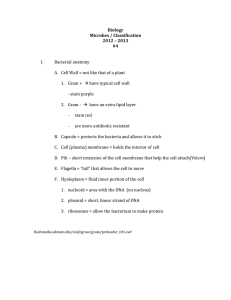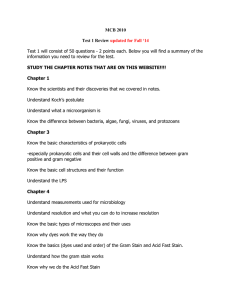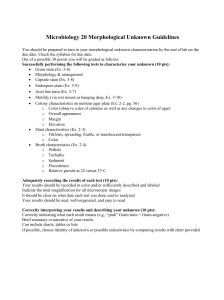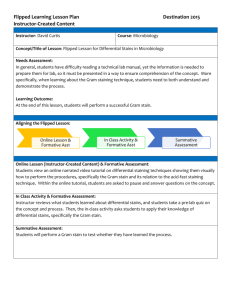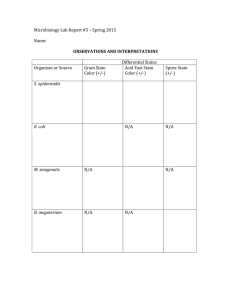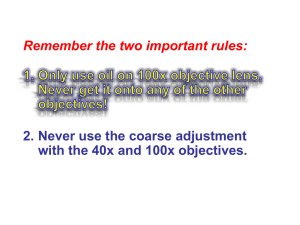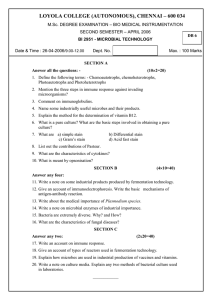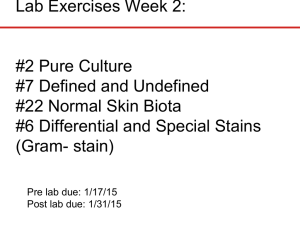Today: Microscopes (Ch. 3), begin Prokaryotic cells (Ch. 4)
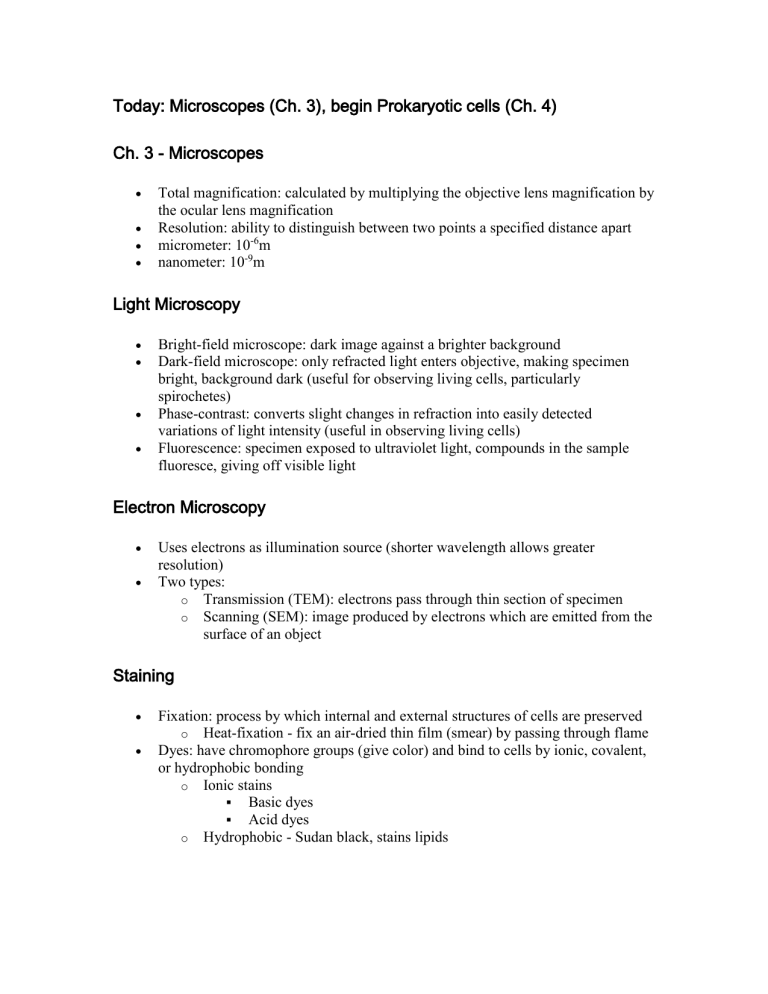
Today: Microscopes (Ch. 3), begin Prokaryotic cells (Ch. 4)
Ch. 3 - Microscopes
Total magnification: calculated by multiplying the objective lens magnification by the ocular lens magnification
Resolution: ability to distinguish between two points a specified distance apart micrometer: 10
-6 m nanometer: 10
-9 m
Light Microscopy
Bright-field microscope: dark image against a brighter background
Dark-field microscope: only refracted light enters objective, making specimen bright, background dark (useful for observing living cells, particularly spirochetes)
Phase-contrast: converts slight changes in refraction into easily detected
variations of light intensity (useful in observing living cells)
Fluorescence: specimen exposed to ultraviolet light, compounds in the sample fluoresce, giving off visible light
Electron Microscopy
Uses electrons as illumination source (shorter wavelength allows greater resolution)
Two types: o Transmission (TEM): electrons pass through thin section of specimen o Scanning (SEM): image produced by electrons which are emitted from the surface of an object
Staining
Fixation: process by which internal and external structures of cells are preserved o Heat-fixation - fix an air-dried thin film (smear) by passing through flame
Dyes: have chromophore groups (give color) and bind to cells by ionic, covalent, or hydrophobic bonding o Ionic stains
Basic dyes
Acid dyes o Hydrophobic - Sudan black, stains lipids
Stains
Simple Stain: uses one staining agent
Differential Stain: divides bacteria into separate groups based on different staining
properties
Gram stain o
most important staining procedure
Dr. Christian Gram, 1884
Procedure:
Crystal Violet - 1 minute
Gram's Iodine - 1 minute
Decolorize with 95% ethanol (5-10 sec), Rinse
Safranin - 1 minute
Stains (continued)
Gram stain (continued) o Gram positive - traps crystal violet-iodine complex, due to thick layer of o peptidoglycan in cell wall
PURPLE
Gram negative - large amount of lipids in cell wall are dissolved by the
95% ethanol, allowing crystal violet-iodine complex to escape, must add counterstain to colorless cells
RED
Stains (continued)
Acid-fast stain: o used to stain
(waxy)
Mycobacterium , which have high mycolic acid content
o Must use steam heat to force carbolfuchsin stain into cells o Acid-alcohol decolorizer removes stain from non-acid fast cells o counterstain with methylene blue
Negative/Capsular stain: o o o reveals capsule layer around cells mix bacteria with nigrosin, spread on clean slide, dry useful to observe Klebsiella pneumonia
Stains (continued)
Spore stain: used to stain endospores of Clostridium and Bacillus o endospores do not readily take up dye, but once it penetrates the stain is o o not easily decolorized heat smear over steam, rinse with water counterstain with safranin o Endospores - Green; Vegetative cells - Red
Flagellar stain: flagella of bacteria are coated with tannic acid or potassium alum and stained with basic fuchsin (Gray Method)
Ch. 4 - Procaryotic and Eucaryotic Cells
General Differences o Procaryotes
generally smaller (0.2 - 2 microns diameter and from 2-8 microns in length) no nucleus or other membrane bound organelles one circular chromosome (most) no histone proteins associated with DNA cell wall generally contains peptidoglycan (complex
polysaccharide) divide by binary fission
Procaryotic and Eucaryotic Cells (continued)
General Differences (cont.) o Eucaryotes
large cells
"true nucleus" and other membrane bound organelles multiple linear chromosomes histone proteins always associated with DNA cell wall does not contains peptidoglycan) divide by mitosis (complex process)
Prokaryotic Cells: Shape and Arrangement
Cell (Plasma) membrane
Structure: o phospholipid bilayer (hydrophilic head and hydrophobic core) o o contains embedded proteins fluid mosaic model
o some infoldings related to photosynthesis (known as thylakoids or chromatophores)
Permeability: o semi-permeable layer
small molecules and water pass freely charged molecules and larger ones cannot pass
Moving materials across the membrane:
Osmosis
Osmosis: diffusion of water across a semi-permeable membrane
Osmotic pressure: internal pressure which equalizes water movement in and out of a cell
Solutions relative to cell solute concentration: o o o isotonic: equal solute concentration hypotonic: lower concentration of solutes hypertonic: higher concentration of solutes
Transport
Passive: o simple diffusion o Facilitated diffusion: protein mediated, no energy involved
Active: o o
Active transport: energy used to bring in molecules
Group translocation: active transport where molecule is modified during transport (example: phosphorylation)
